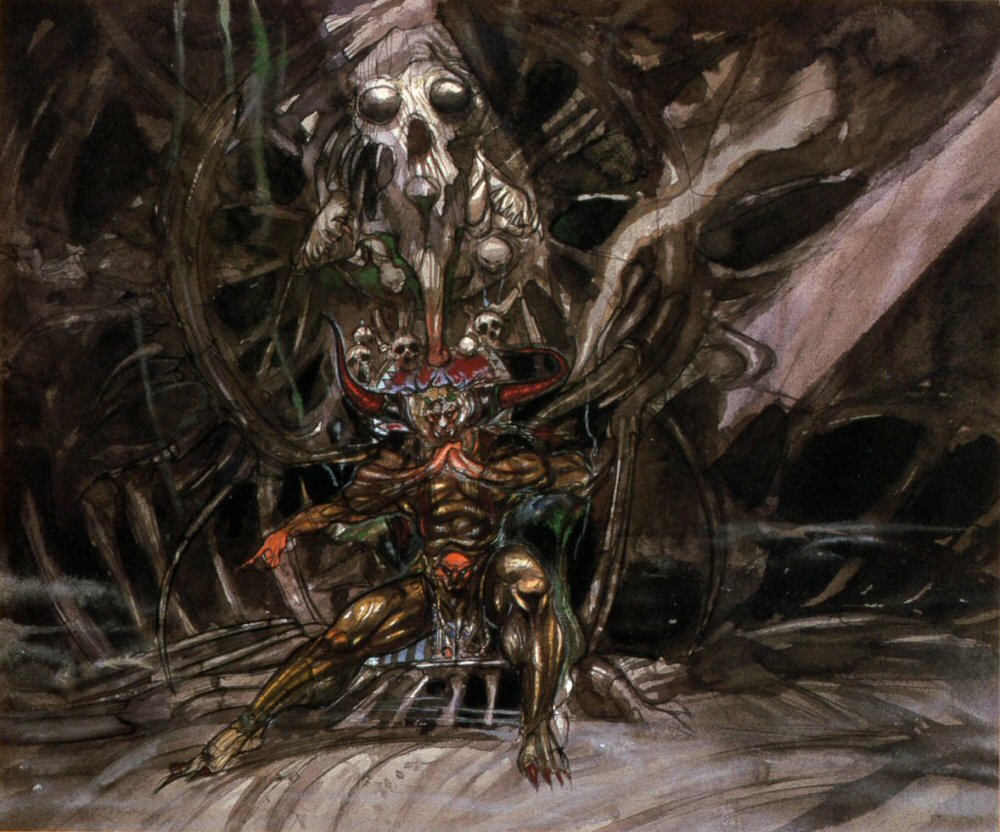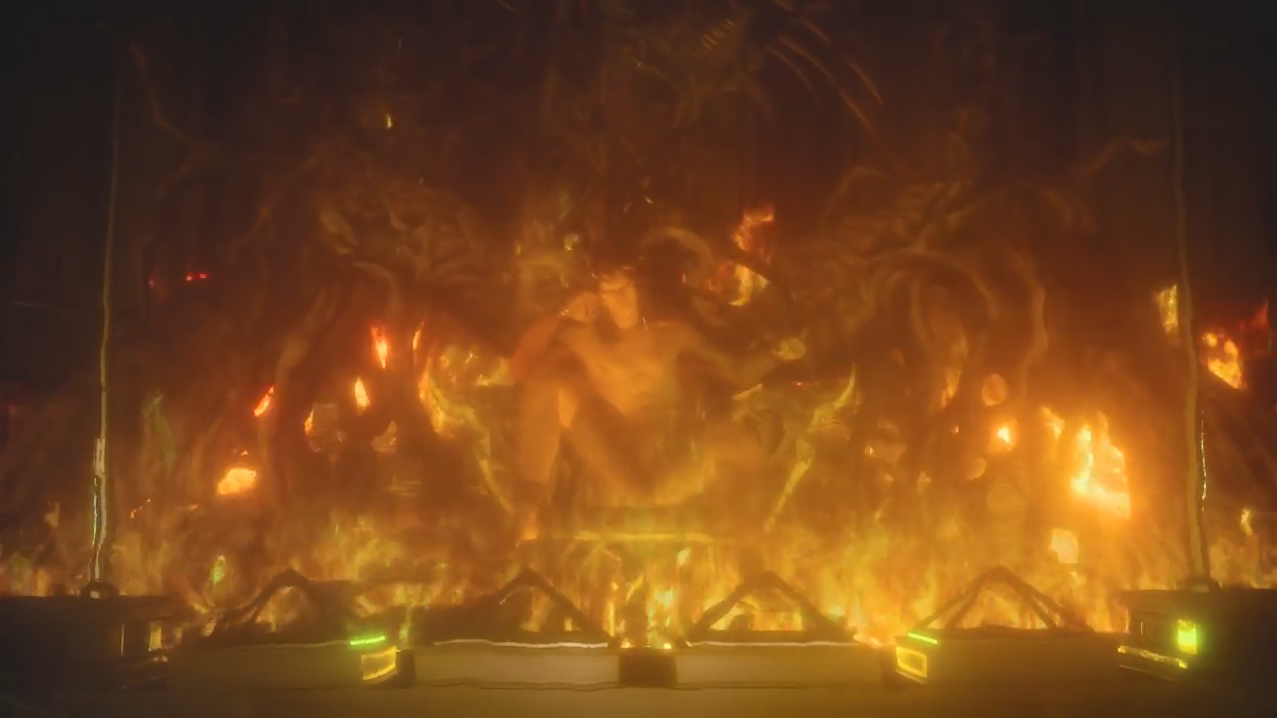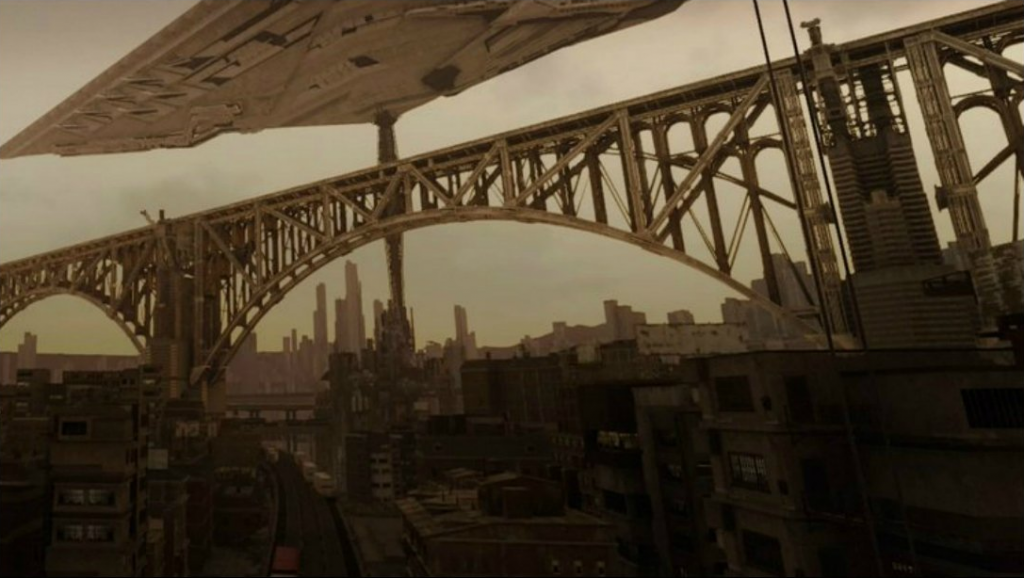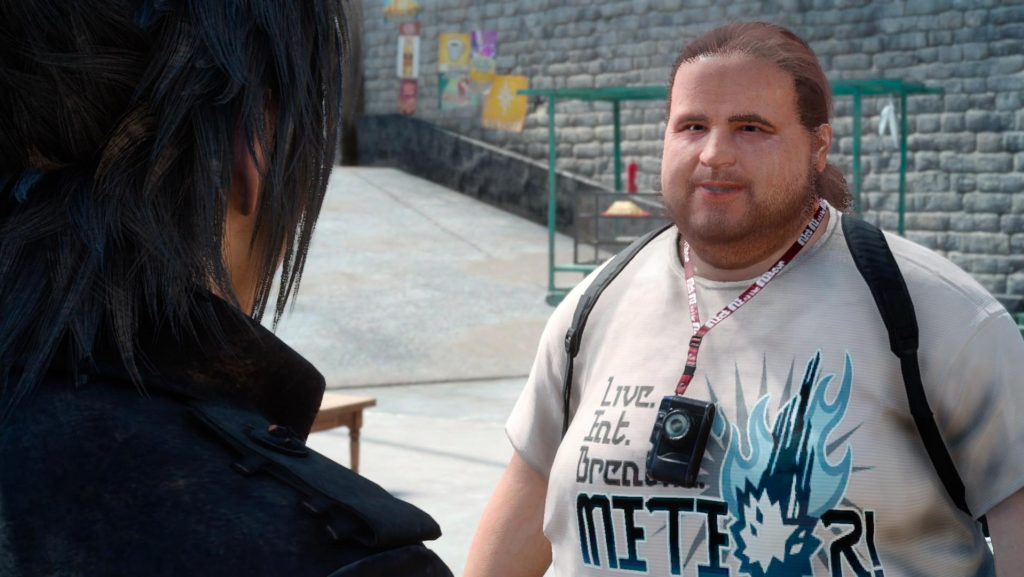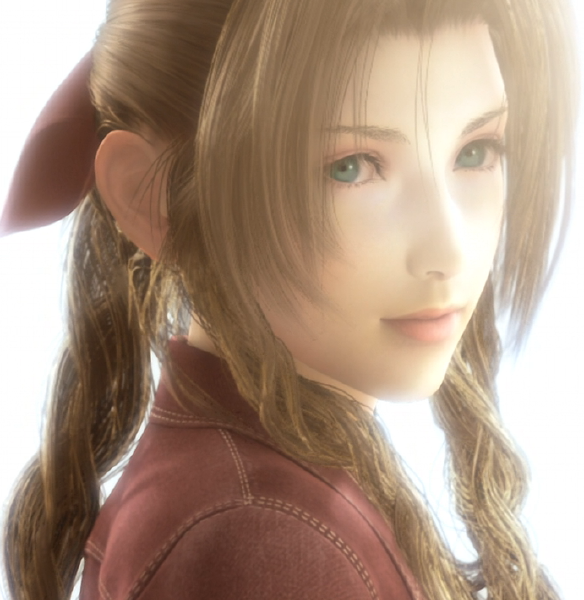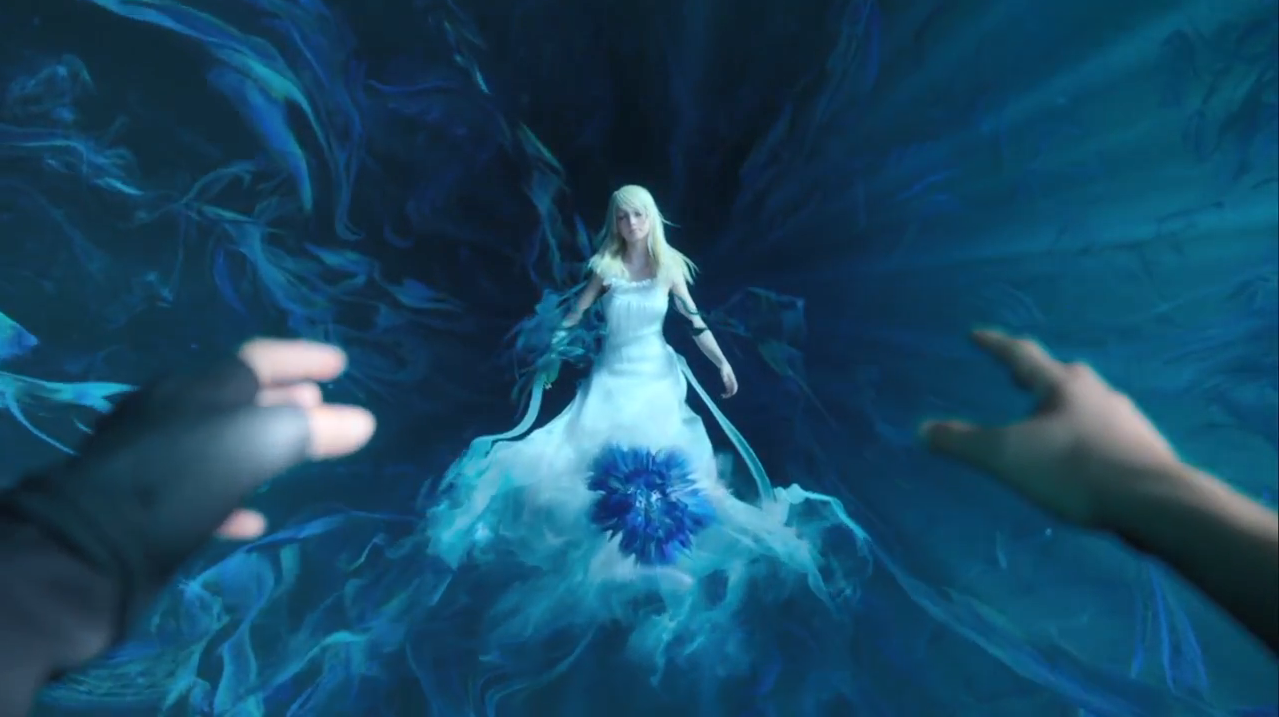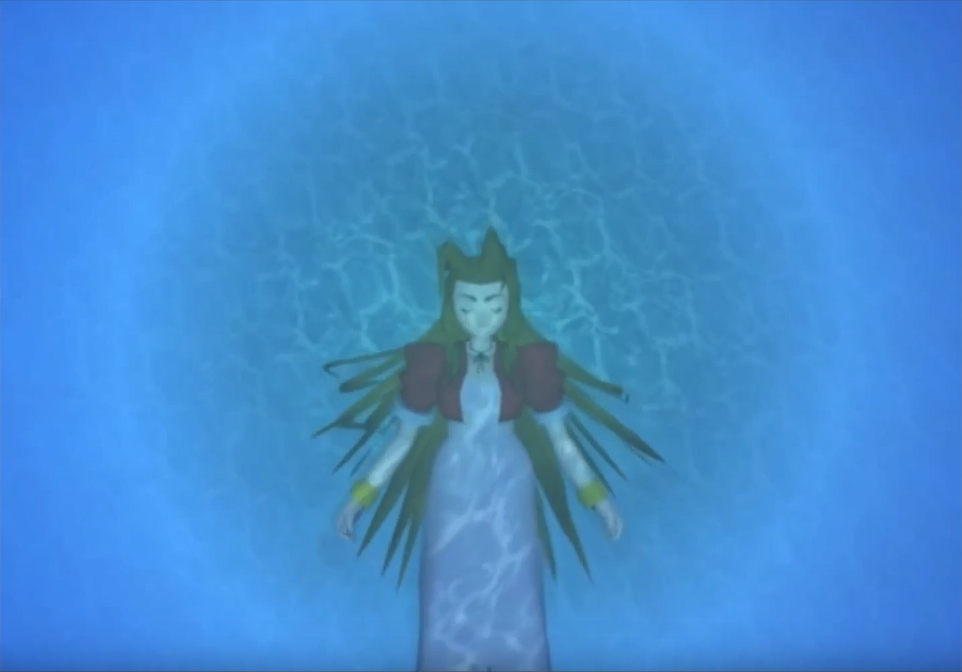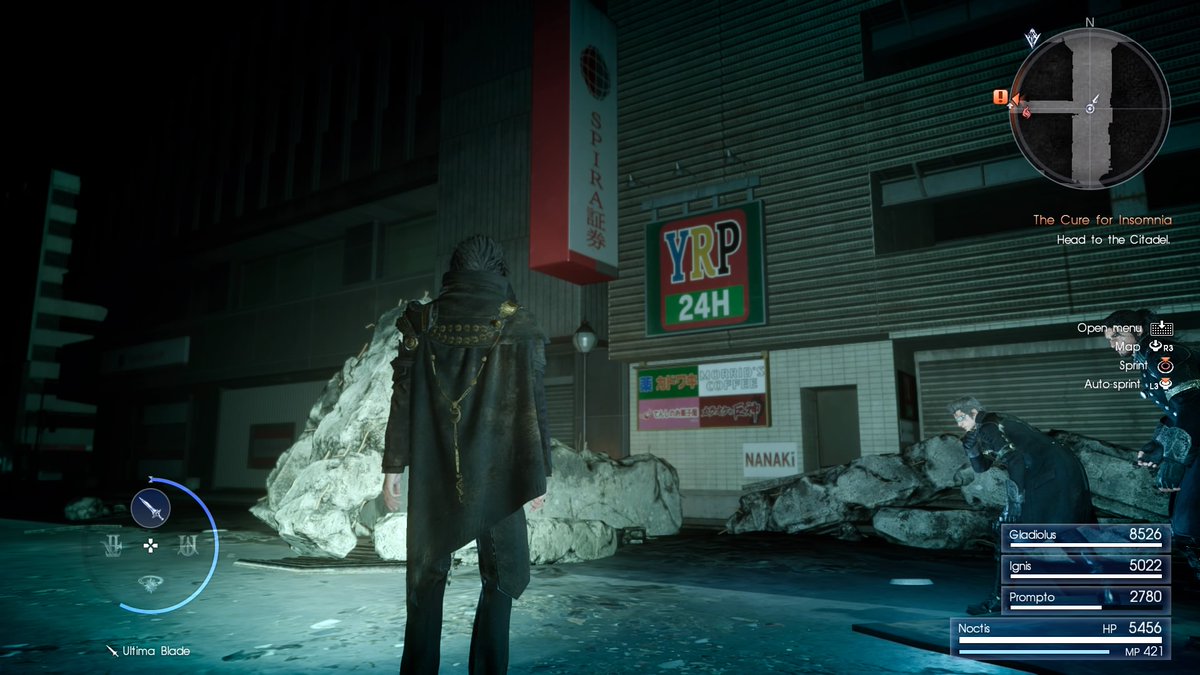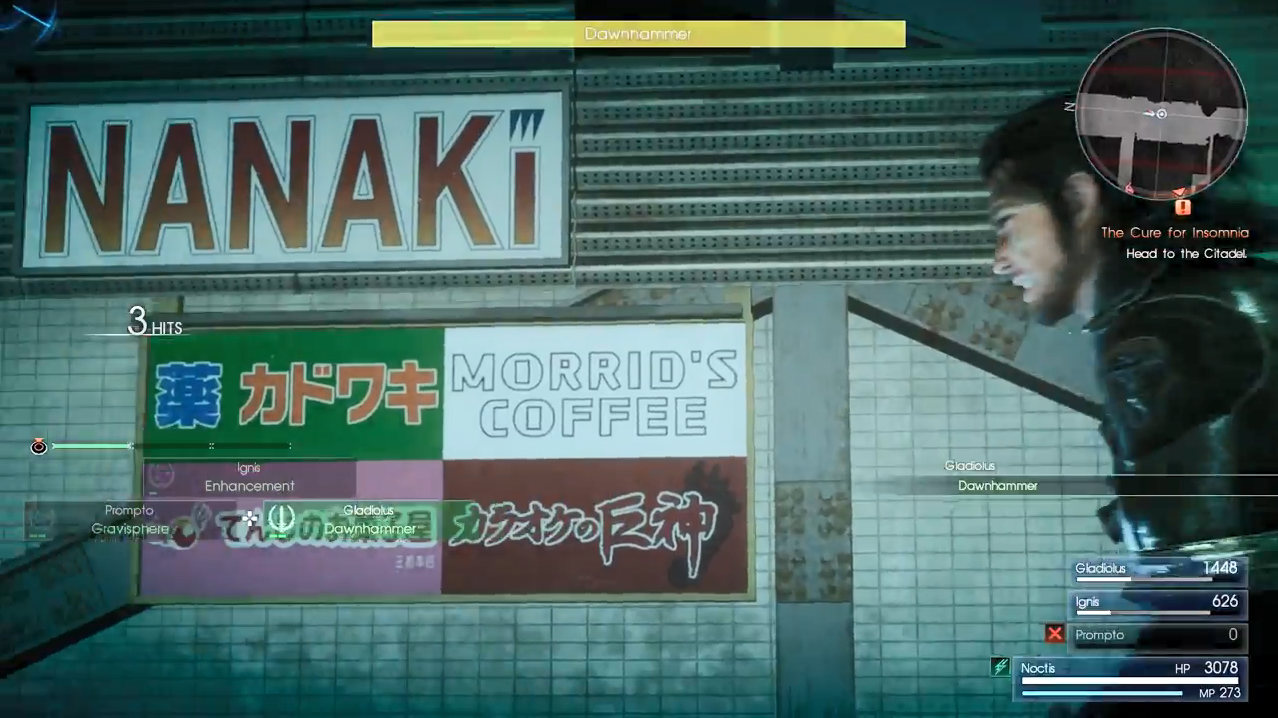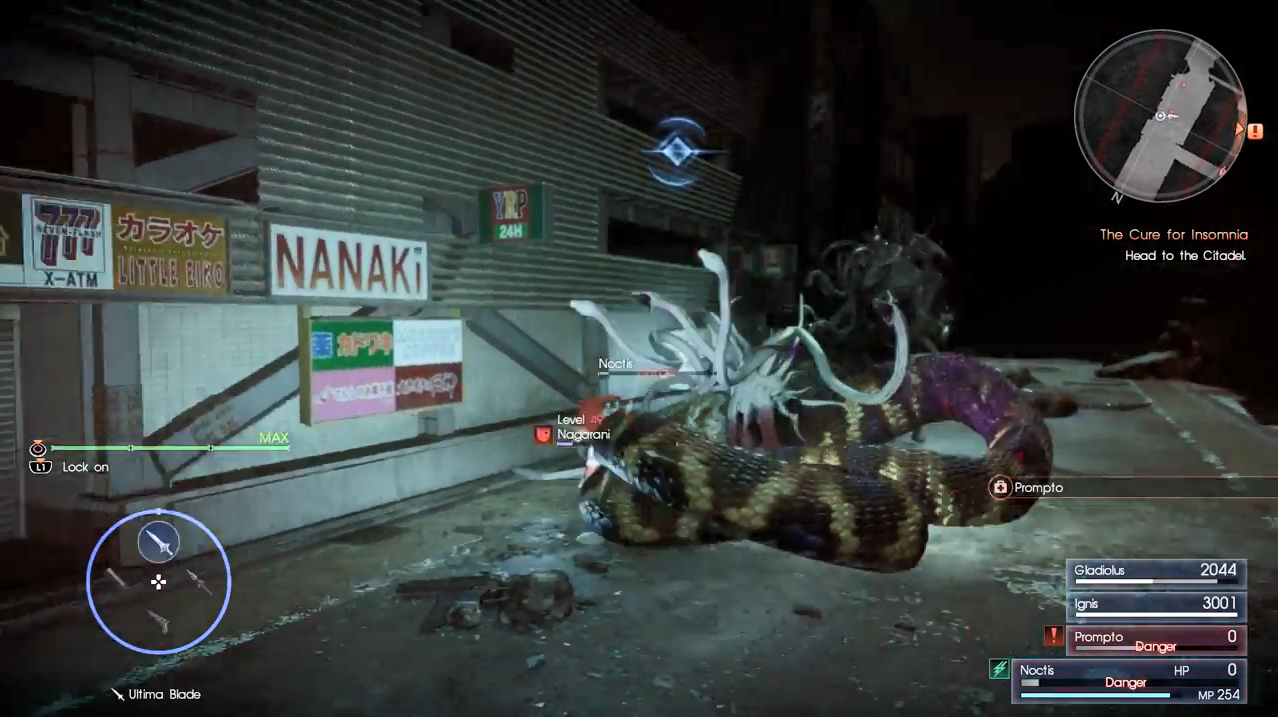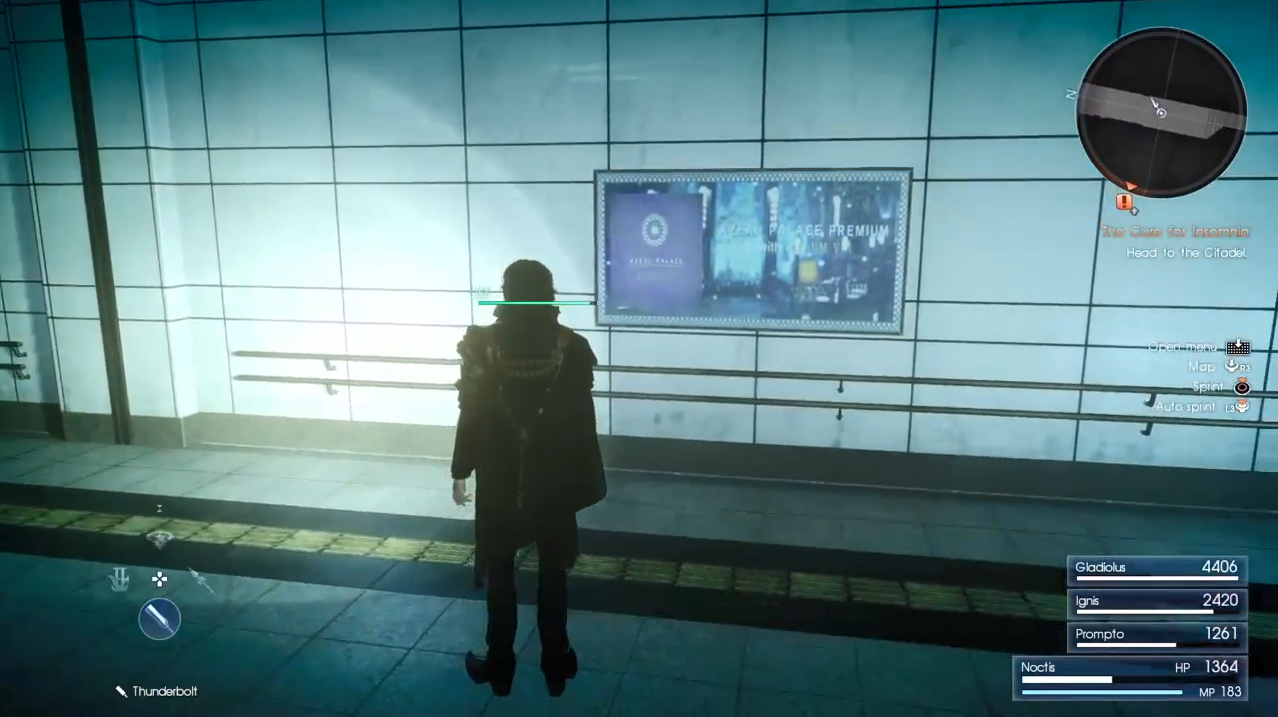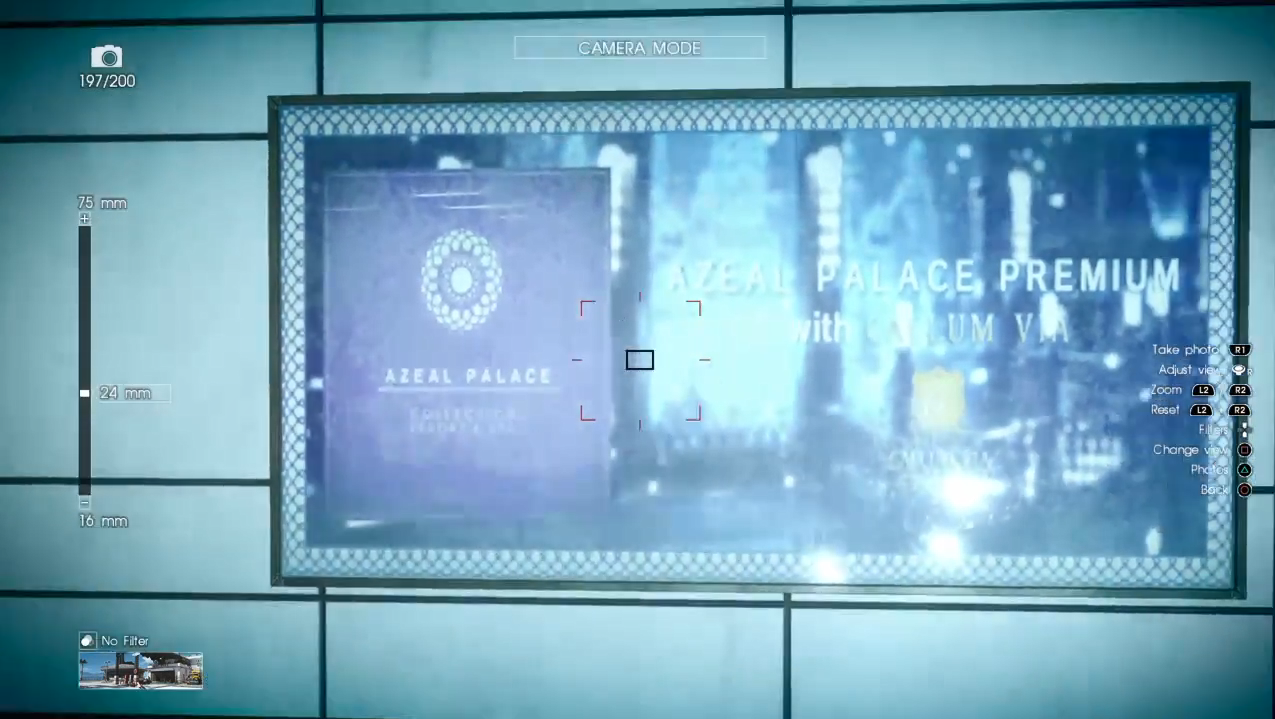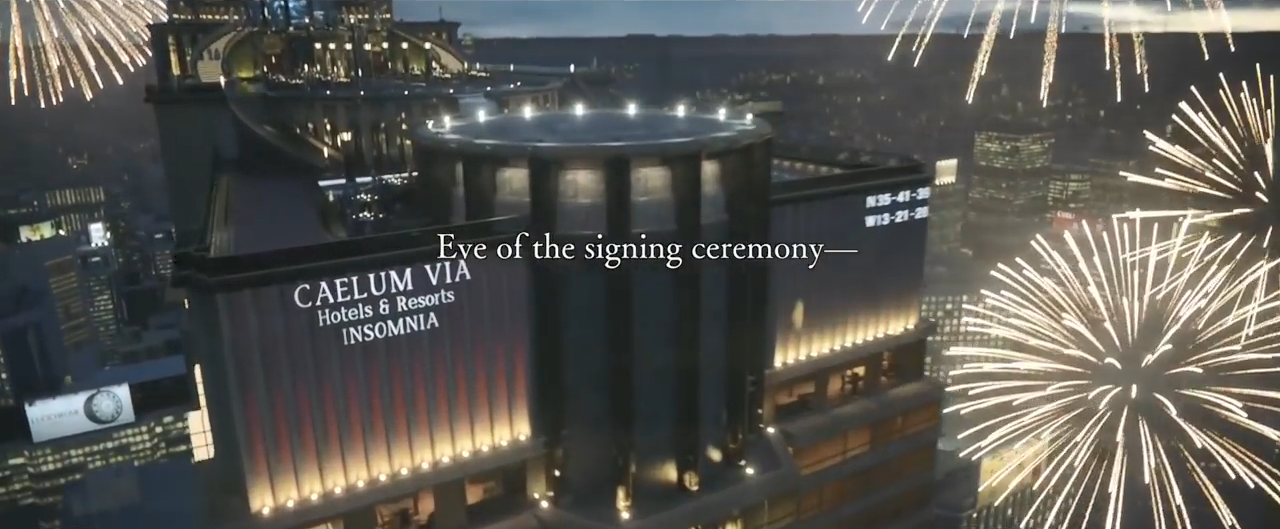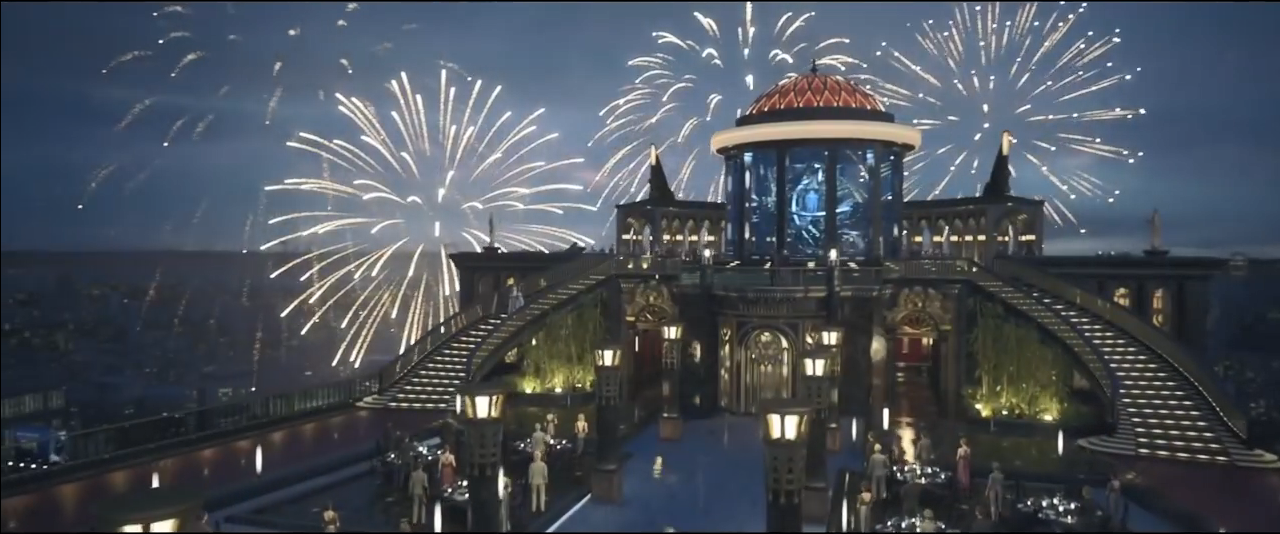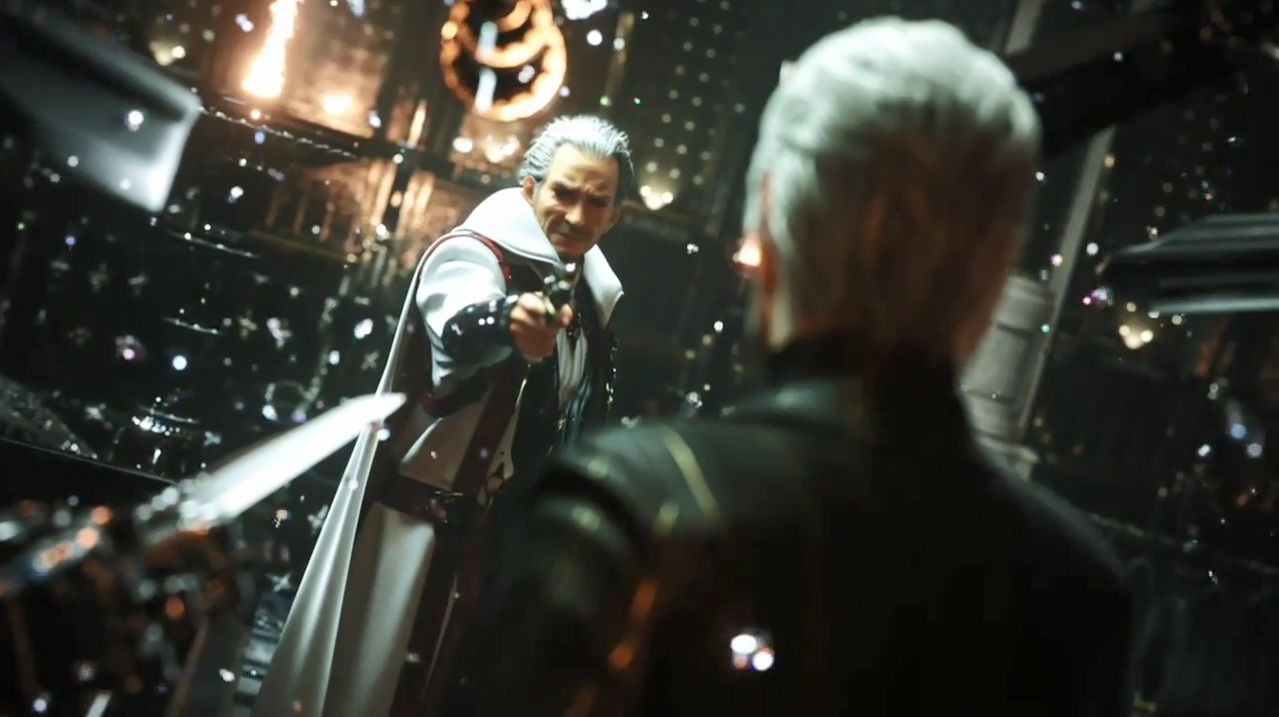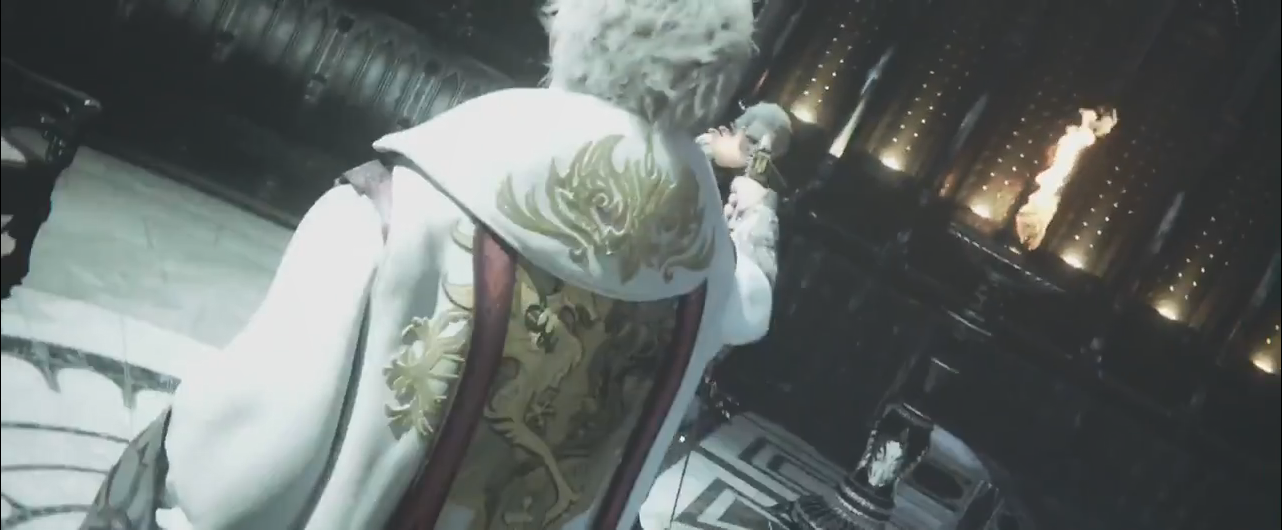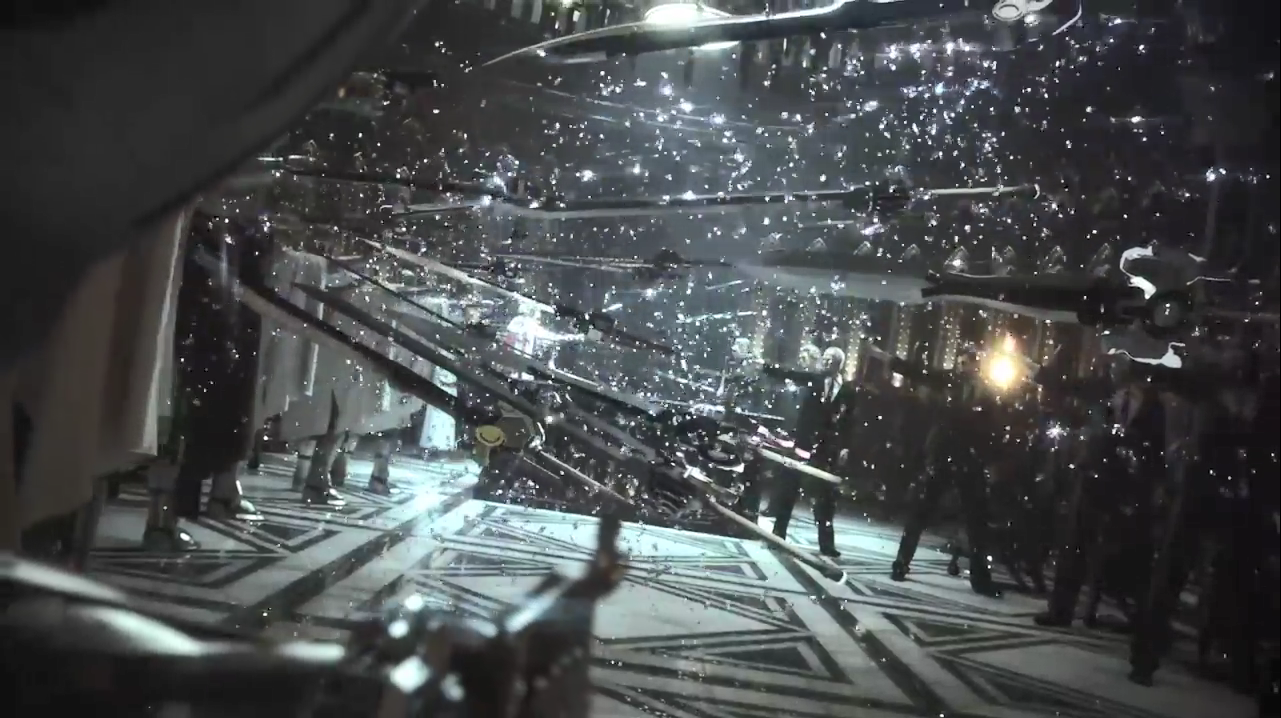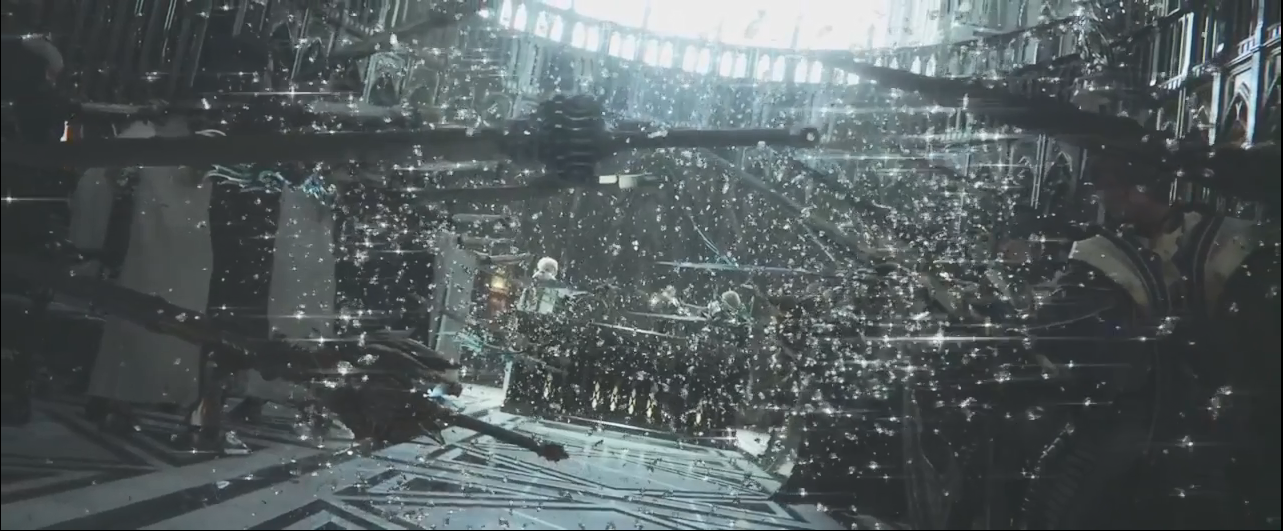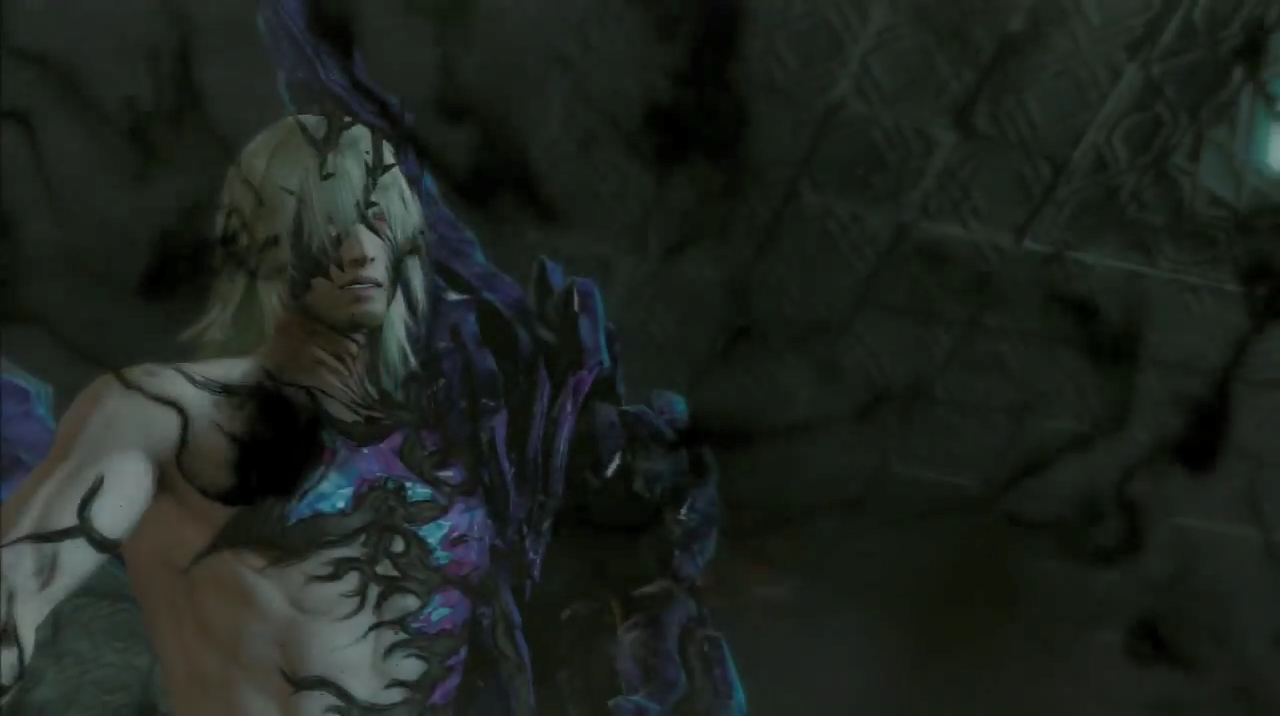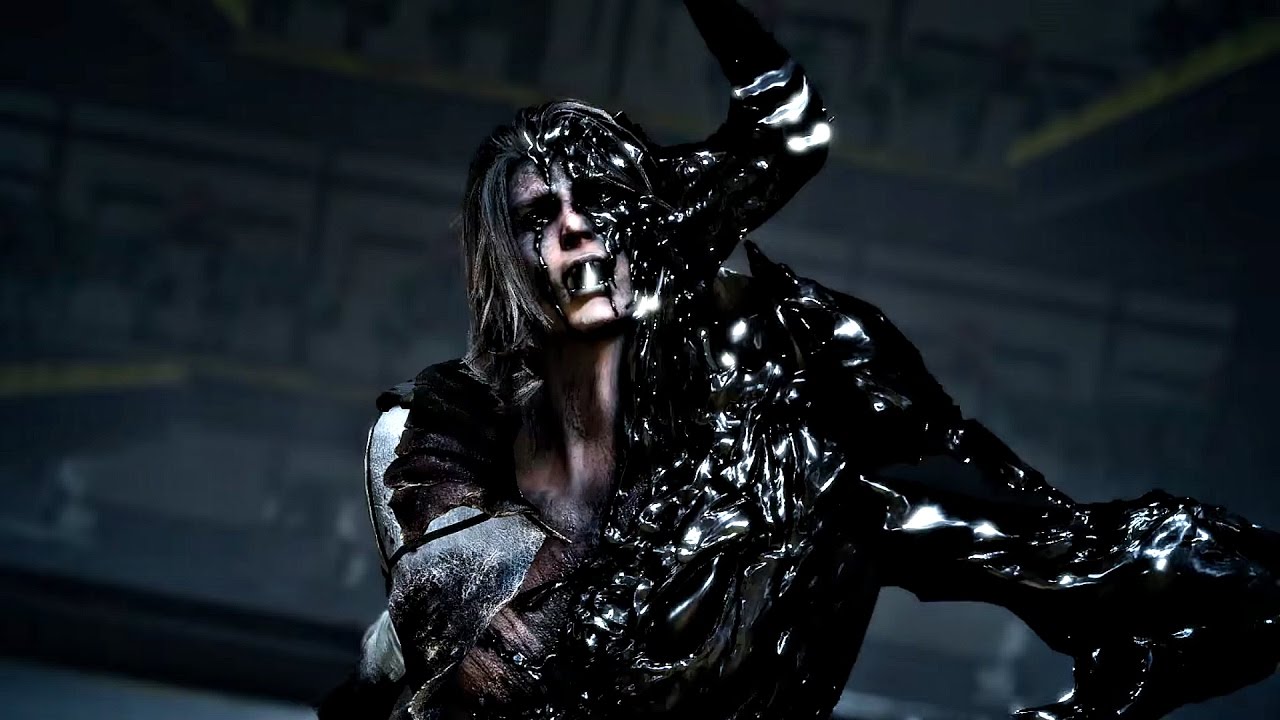Allusions and references to past Final Fantasy projects in FFXV
It wouldn’t be unreasonable to describe Final Fantasy XV as a “greatest hits” of sorts for the Final Fantasy series, slapped together from elements from across the series. As such, there are numerous allusions to past works visible in the characters, setting and plot; and even more Easter Egg-style references.
Without assuming the following observations to necessarily be comprehensive, here are many elements of FFXV that call to mind the game’s lineage:
The original Final Fantasy’s Warriors of Light
[Note: To the best of this archivist’s knowledge, Final Fantasy XV fan YANN_LIFE was the first to propose a version of this theory]
Though Noctis alone is the King of the Light, he, Ignis, Prompto and Gladiolus essentially occupy the role of the Warriors of Light in Final Fantasy XV. The prophecy from the beginning of the original game is referenced immediately in the opening to FFXV:
shrouded in darkness.
The winds die…
The seas rage…
The earth decays…
But the people believe
in a prophecy, patiently
awaiting its fulfillment.
“When darkness veils the
world, four Warriors of Light
shall come.”
—Official English localization to the “Dawn of Souls” version of the first FF
In a time unknown, only a prophecy keeps hope alive in people’s hearts: “When darkness veils the world, the King of Light shall come.”
Now, four brave warriors begin their journey, prepared to fight. What awaits the four, however, they do not know.
—Opening to FFXV
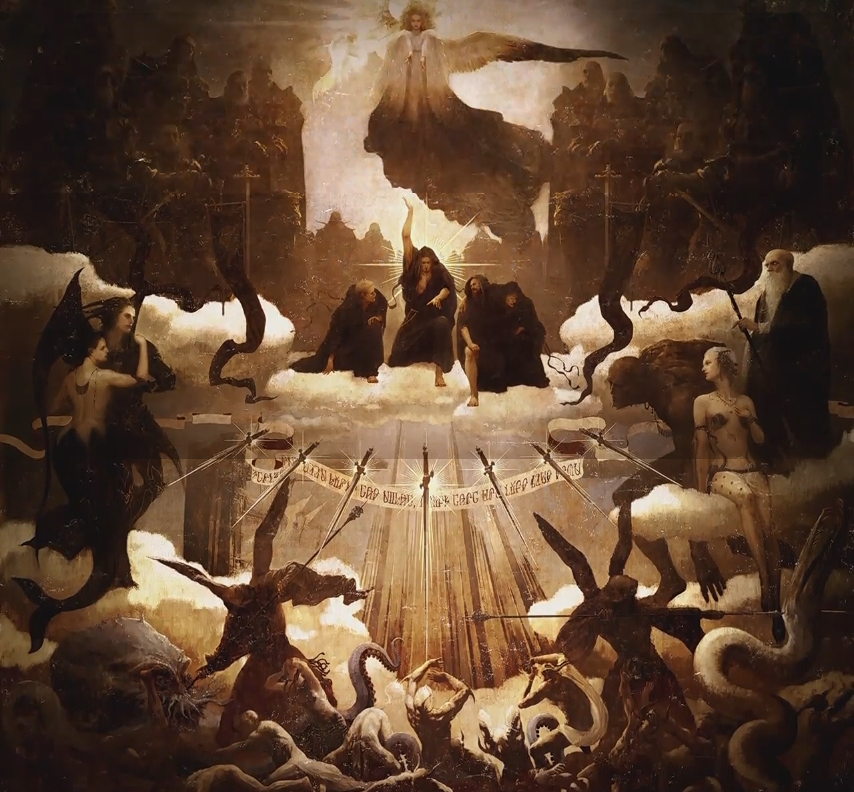
What’s more, the in-game painting depicting FFXV’s prophecy rather blatantly depicts its four main characters at the center of the image: Going from left to right, Prompto is the one to the far left with short blond hair; Noctis, the King of Light, is next; then Gladiolus, with the most facial hair, who is supporting the blind Ignis on the far right.
The allusions don’t end there. In addition to the prophecy displayed when starting a new game, the battle these four Warriors of Light will wage against Ifrit is previewed from the outset. While Ifrit didn’t appear in the original Final Fantasy, FFXV’s Ifrit sits here in a manner and upon a throne highly reminiscent of Chaos, the final boss of the original Final Fantasy, as seen in this concept art of the character by Yoshitaka Amano:
One final piece of iconography from the original Final Fantasy to be referenced early in Final Fantasy XV is the image of the four Warriors of Light standing on a hill after crossing a large bridge, looking out over a body of water toward the castle of the kingdom of Cornelia.
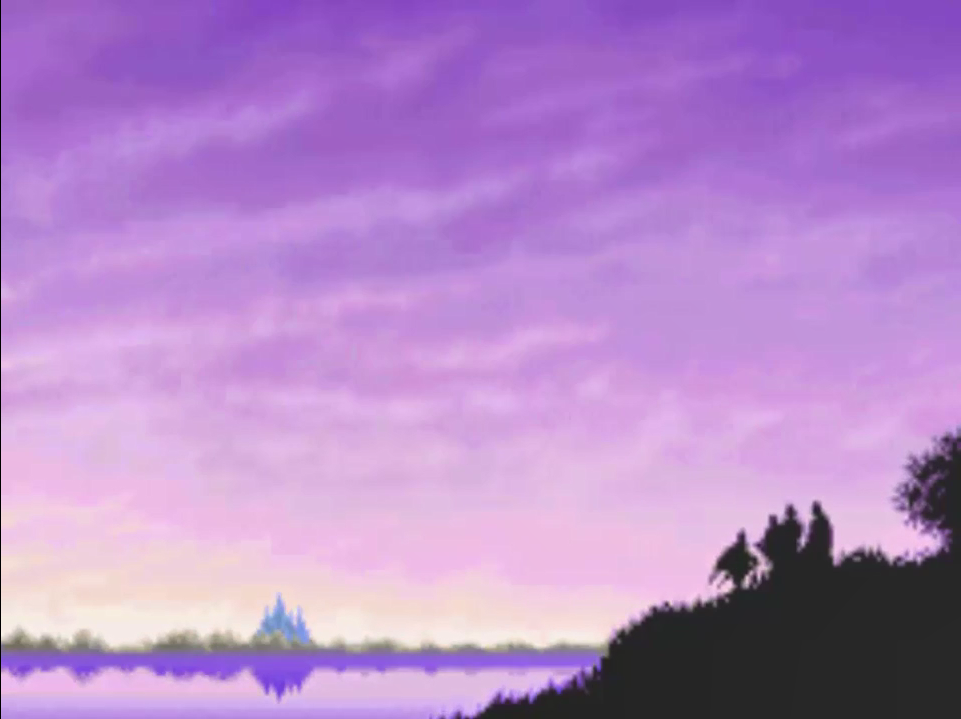
This image occurs early in the game, after the “first chapter,” so to speak, has concluded. It is also at this point that their journey is said to really begin — though, ironically enough, a seemingly inconsequential enemy they encountered just prior to this will eventually be revealed as the game’s final boss in the form of Chaos.
Similarly, Ardyn Izunia, FFXV’s main villain and final boss, introduces himself to the royal retinue as “a man of no consequence” shortly before the end of Chapter 1 — which ends with a shot of Noct, Ignis, Gladio and Prompto standing upon a hill with a large bridge nearby looking out over a body of water toward the capital city of their kingdom:

Seem familiar?
A final, related note: Given that it was their destiny to bring the Dawn, one could also make the case that this was an additional allusion to the Four Warriors of Dawn from Final Fantasy V.
Ultros (FFVI)
“Kingsglaive: Final Fantasy XV” includes a significant cameo by the purple octopus who makes for perhaps the most memorable and beloved boss of Final Fantasy VI. As in the second encounter with him from that game, he’s fought on an airship in “Kingsglaive.”
The Empire (FFVI)
Though more than a few Final Fantasy games have featured an aggressive empire seeking to conquer the world, FFXV’s empire is clearly modeled in reference to FFVI’s — Emperor Iedolas Aldercapt resembles Emperor Gestahl in appearance and personality; Ardyn occupies a similar role in FFXV’s story to Kefka’s role in FFVI; and both empires make prolific use of magitek.
Despite not being emperor, both Ardyn and Kefka ultimately serve as the main villains of their respective games, having brought civilization to an end. After an extended period of humanity surviving in a seemingly hopeless world of ruin (one year in FFVI; ten years in FFXV), a protagonist awakens from a long sleep, reunites with lost friends, and restores light to the world.
Magitek, meanwhile, occupies a similar role between both games. Final Fantasy XV even has its own versions of FFVI’s iconic magitek armors. A notable difference between the magitek seen in the two games, however, is that FFXV’s magitek is unrelated to the game’s summon entities (i.e. the gods) while FFVI’s magitek was derived from the crystallized spiritual essence of dead espers.
Great War of Old/Astral War/War of the Magi (FFVI)
The Japanese name for what the English localization calls the the Great War of Old (魔大戦) and the Astral War is the same term used in the Japanese version of Final Fantasy VI for what that game’s English localizations have named the War of the Magi.
The Chadarnook (FFVI)
This malevolent entity inhabiting the Lakshmi painting in Altissia is a reference to the Chadarnook from FFVI, which had also possessed a painting in that game. Defeating FFVI’s Chadarnook earned players the Lakshmi magicite (localized as “Starlet” in some English releases), the true target of the entity’s intentions.
World of Ruin (FFVI)
Technically, this reference doesn’t apply by name in the Japanese version of FFXV even if the plot point definitely does. The Japanese name of the Chapter 14 quest localized as “World of Ruin” was “夜に包まれた世界” (“A World Wrapped in the Night”) while FFVI’s World of Ruin was called “世界崩壊後” (“World After the Fall”) in Japanese.
Diamond Weapon (FFVII)
Several enormous daemons featured in “Kingsglaive: Final Fantasy XV” bear the appearance and abilities of Final Fantasy VII’s Diamond Weapon. The creature’s name was confirmed for the FFXV incarnation in “Episode Prompto”
Knights of the Round (FFVII, FFXIV: A Realm Reborn)
The designs of Insomnia’s Old Wall, and, thus, the Lucii monarchs featured in “Kingsglaive: Final Fantasy XV” and the main FFXV game itself were confirmed to be the Knights of the Round in the credits to “Kingsglaive”:

It’s also worth mentioning that at least four of the five Armiger weapons featured in the “Episode Duscae” demo were named in reference to weapons that belonged to the Knights of the Round Table in Arthurian legend. Granted, some of the ideas behind the weapons obviously changed in development between “Episode Duscae” and the final release, but the notion was obviously in play to some degree then as well.
Meteor (FFVII)
Final Fantasy XV’s lore borrows not only Diamond Weapon and the Knights of the Round from Final Fantasy VII, but also the inciting event behind most of its plot: the arrival of a meteorite approximately 2000 years before the main events of the game. Additionally, in both cases, the meteor in question was the carrier of an alien parasite that turns people into monsters and stands as an antithesis to the planet’s own essence.
(For more on this topic, see “Where did the Starscourge come from?” under the “Theories and observations about the story and world of FFXV” page.)
In addition, Vyv’s shirt of the Meteor vaguely resembles Final Fantasy VII’s logo, which depicts that game’s Meteor spell.
Sephiroth (FFVII)
Final Fantasy VII’s legendary villain has (or had at one time) a number of references to him in Final Fantasy XV. Among these, in part, is FFXV’s own main villain, Ardyn.
Obviously there are traces of not just Sephiroth, but also Kefka and Kuja in Ardyn — Kefka for reasons gone over above; Kuja because of his theatrical mannerisms and speech, and also because he manipulated a warmongering head of state’s lust for power to his own destructive ends. That said, there is definitely more than a nod or two from him in Sephiroth’s direction.
First and most obviously, the large black wing Ardyn is sometimes seen carrying with him on one side invokes Sephiroth’s “one-winged angel” motif and the single black wing often seen on his right side (by contrast, Ardyn carries his wing on his left side).
Secondly, both were once hailed as heroes only to later feel they had been supplanted of their rightful place in the world by traitors. “His mind twisted by spite and bent on revenge, the Usurper came to bring darkness down upon our world” — while that’s Bahamut talking about Ardyn in FFXV, it would also be an apt description of Sephiroth in Final Fantasy VII and its film sequel, “Advent Children.”
Furthermore, both villains also came to literally embody a parasitic alien influence seeking to contaminate their world even as they simultaneously carried out elaborate plots of petty personal revenge against their game’s protagonist — and like Sephiroth, in order to truly negate his ability to influence the world, Ardyn ultimately had to be defeated on the spiritual plane after his body has already been destroyed.
Defeated in both cases by a rapid, cinematic series of melee attacks (Omnislash in Sephiroth’s case; Knights of the Round in Ardyn’s), this is followed by the villains’ malicious wills seemingly being neutralized, their negative spirits purified, and their spiritual energy diluted into the greater soul of their respective planets.
Not surprisingly in light of all this, Lunafreya is to Ardyn as Aerith is to Sephiroth — both because she was murdered by him about halfway through the game, and because she lends a hand in purifying his negative spiritual essence at his final defeat (for Sephiroth, this would come in “Advent Children”).
[Additional note on the above: In both villains’ cases, the hostile alien lifeform for which they came to serve as the human embodiment had also arrived on a meteor approximately 2000 years before the main events of their respective games; for more on this topic, see “Where did the Starscourge come from?” under the “Theories and observations about the story and world of FFXV” page]
Another reference to Sephiroth that had been intended to appear in FFXV but was cut would have been an imperial general named “Safeiroth,” as revealed by RPG Design Lead Takatsugu Nakazawa in FFXV’s Battle+Map Side Ultimania:
“The ‘SAF’ letters inscribed on the imperial army’s drop ships, etc. are a marker representing the troops of a General Safeiroth, who was supposed to appear at first. He no longer appears, but the letters remain within the world setting as something of a ‘tribute to a celebrated general who once existed.’
Aerith (FFVII) and Yuna (FFX)
In Lunafreya there are a number of associations with Final Fantasy VII’s Aerith and Final Fantasy X’s Yuna to be observed. First, and perhaps most obviously, all three occupy the somewhat archetypal role of a maiden of special lineage and power.
Though it’s difficult to say who Lunafreya bears the most similarities to, for many fans, the Oracle’s death approximately halfway through XV’s story will most call to mind Aerith, who suffered a similar tragic fate about halfway through her game.
Indeed, the imagery of her sinking into the sea at Altissia even recalls Aerith’s burial:
Ironically enough, though, when the similarity was pointed out in an interview with FFXV director Hajime Tabata on pg. 596 of the FFXV Scenario Side Ultimania, he explained that some of his staff likely arranged the shot as an homage to Aerith while he personally had Yuna in mind more for inspiration:
Tabata: I see that. I think the staff who worked on the production of that scene probably put that in as an homage to FFVII. For myself, I was more conscious of FFX’s Yuna than Aerith. I wanted to make the heroine of FFXV a distinct character from Yuna. In FFX, there’s a scene that’s iconic of Yuna where she dances on water, and it’s fantastic and mysterious, and so the result of exploring a different direction from that as a scene that would be appropriate for Lunafreya is the scene in Altissia where she’s surrounded by soldiers of the imperial army and shows off her willpower with that resolute attitude.
Though Tabata intended for the image of Lunafreya maintaining her composure with guns in her face to be her iconic imagery, in another turn of irony, fans think more of her standing at the water altar for the covenant with Leviathan. In the end, all three of these Final Fantasy heroines have iconic imagery of them standing over or sinking beneath water, and for two of them, that imagery includes an altar.
One way in which Tabata may have gotten his wish for contrasting Lunafreya with Yuna specifically, though, is her name. Within the story of FFXV, it’s established that Yuna is named after Yunalesca, an important figure in Spira’s history. “Lunafreya” and “Yunalesca” have a similar meter to them, and in both heroine’s cases, these names become shortened for them to the similar “Luna” and “Yuna” — which, incidentally, both mean “moon” (in Latin and Okinawan respectively).
A final common thread between the three women is healing. Where Lunafreya and Aerith are concerned, this is obvious — they use their powers to heal the Starscourge and geostigma. What you may not know, though, is that the concept that became geostigma for “Advent Children” arose from a rejected idea originally intended for Final Fantasy X. As revealed pg. 70 of the “Reunion Files” by frequent FF scenario writer Kazushige Nojima, Yuna was once envisioned as healing people afflicted with disease during her travels.
Obviously this latter notion didn’t come to pass, but Yuna’s role in FFX still finds her in the position of bringing a healing of sorts to Spira’s people, and being greeted with much the same adoration as Lunafreya.
Verstael and Prompto
While neither character is an outright reference to any particular past FF in the same way magitek is, Verstael’s character design has some similarities to that of Final Fantasy IX’s Garland, who also produced a series of clones as part of a plan of conquest.
Overall, though, Verstael has the most similarities to Hojo from Final Fantasy VII, who likewise had a “clone” project related to enhanced soldiers, also found a way to cheat death by living on through machines, and was pretty much certifiably insane.
Prompto has similarities to both Cloud from FFVII and Zidane from FFIX in that those characters were subjects of the clone projects conducted by Hojo and Garland (though Cloud wasn’t a clone in the same way Prompto or Zidane are — i.e. he was not a genetic duplicate of someone else). Like both, Prompto learns who he is during the course of the game and wrestles with what it means about his worth. Also like both, he desperately wants to feel that he belongs.
Like Cloud in particular, he’s told that he’s a failure by the one who conducted the experiment he was part of. And like Zidane, he was kidnapped as an infant, then abandoned in the land of the people he was meant to help conquer, instead growing up to love and defend his unintended home.
Aranea Highwind
Aranea’s last name is a common one in the FF series, often as the surname of dragoons like her. Even if not used in this capacity, the name is typically in some way associated with dragoons, wind or the sky.
Past Highwinds to wield a lance and take to the skies are Ricard Highwind from Final Fantasy II, Kain Highwind from Final Fantasy IV, and Cid Highwind from FFVII. Meanwhile, King Alexander Highwind Tycoon from Final Fantasy V is the guardian of the Wind Crystal.
Auracite and Zodiac Stones
The object referred to as the Crystal in the English localization is normally referred to by the same word in Japanese (“クリスタル” is the English word “crystal” rendered in Japanese katakana, and its pronunciation is an approximation of how it’s pronounced in English). However, the artifact is referred to by the gods as the “聖石” (“Holy Stone”) in Japanese — the same Japanese term often used for the Zodiac Stones in Final Fantasy Tactics, as well as the Japanese name for auracite in Final Fantasy XII and Final Fantasy XIV.
Cerberus
Creatures (and more) based on the three-headed dog guarding the gates of Hades in Greek mythology have appeared in multiple Final Fantasy titles, and included everything from bosses (FFIII and FFXIV), ordinary random enemies (FFIX), a summon (FFVIII), and even a gun (Dirge of Cerberus).
The FFXV Universe’s iteration are fire-breathing daemons that appear in “Kingsglaive” and the “Omen” trailer. They bear a strong resemblance to FFVIII’s Cerberus, though with the addition of the lava and flames that spew from their jaws.
Contrasting FFXV with FFVIII
Final Fantasy VIII is arguably the FF most similar to FFXV in many, many ways.
They have fairly similar worlds, what with the mix of technology and magic in a mostly modern setting inspired by the real world. In terms of gameplay, even though FFVIII is turn-based, you see the beginnings of certain game design and battle mechanics that would eventually make their way into Noctis’s play style — e.g. the timing mechanic involved with Squall’s gunblade, as well as a few boss-specific unique Renzokuken sequences that remind one of the unique parry sequences in Final Fantasy XV.
On a somewhat cheekier note, using magic in battle also isn’t particularly necessary for either game.
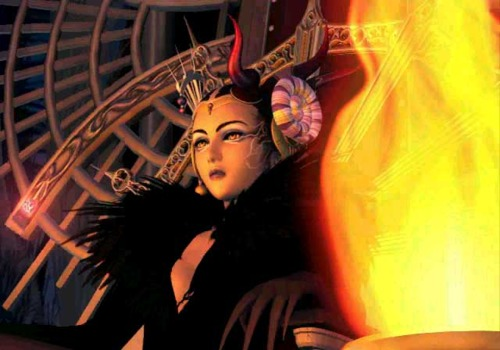
FFVIII’s setting is also an interesting foil for FFXV’s in a way, as there is a figure like the Oracle present there as well — but the people of FFVIII’s world feel the opposite way about these woman that Eos’s populace feel about Lunafreya or her mother, Sylva.
On a related note, one has to wonder if Kimya in XV — in addition to serving as part of a story to parallel Ardyn’s — reflects a certain self-awareness on the part of the development team here. Kimya is referred to as a witch, with the same word used in reference to her in Japanese as was used for the women in Final Fantasy VIII mentioned above: 魔女 (the official English localization of FFVIII went with “sorceress”). There’s little reason, however, that the alchemy practiced by Kimya — whose name, incidentally, is likely derived from “kimiya,” the Arabic word for “alchemy” — should be so feared when the Oracle is so beloved despite wielding genuine magical powers.
Insomnia billboards and other signs
Though not part of the lore of the FFXV Universe per se, and not even necessarily part of its world building in any meaningful capacity, these Easter Egg-style references are no less notable for Final Fantasy fans.
Gil
(the currency featured throughout the FF series)
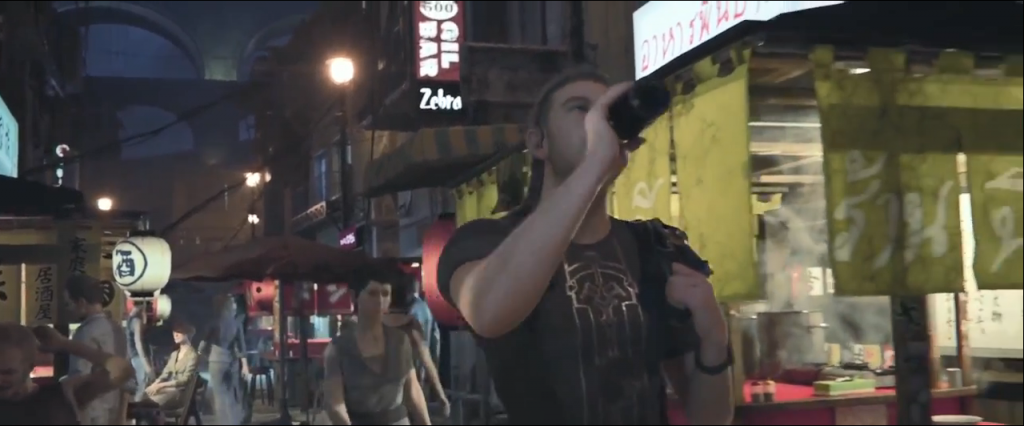
ATB
(the Active Time Battle system featured in FFIV through FFIX)
Kazusa
(character in FF Type-0)
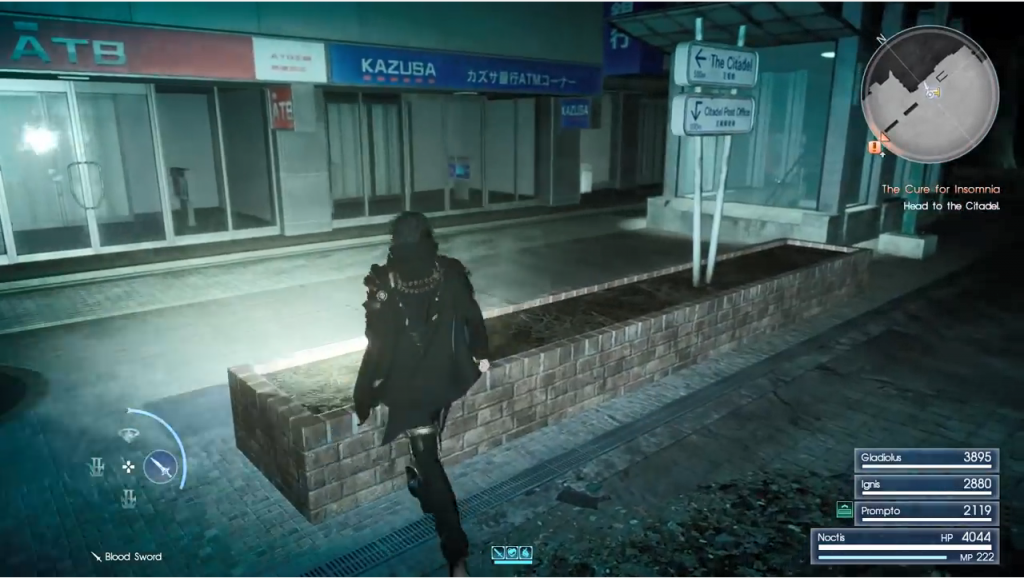
3Stars
(accessory found in a number of FF games)
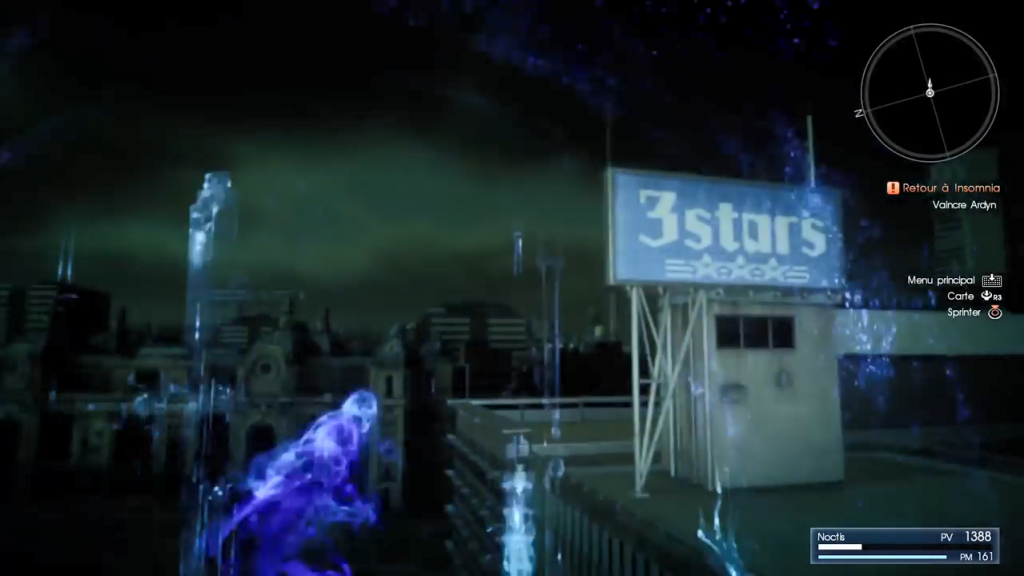
Regen
(a curative spell found in many FF games)
Eden
(a summon in FFVIII; a city and the fal’Cie entity maintaining it in FFXIII)
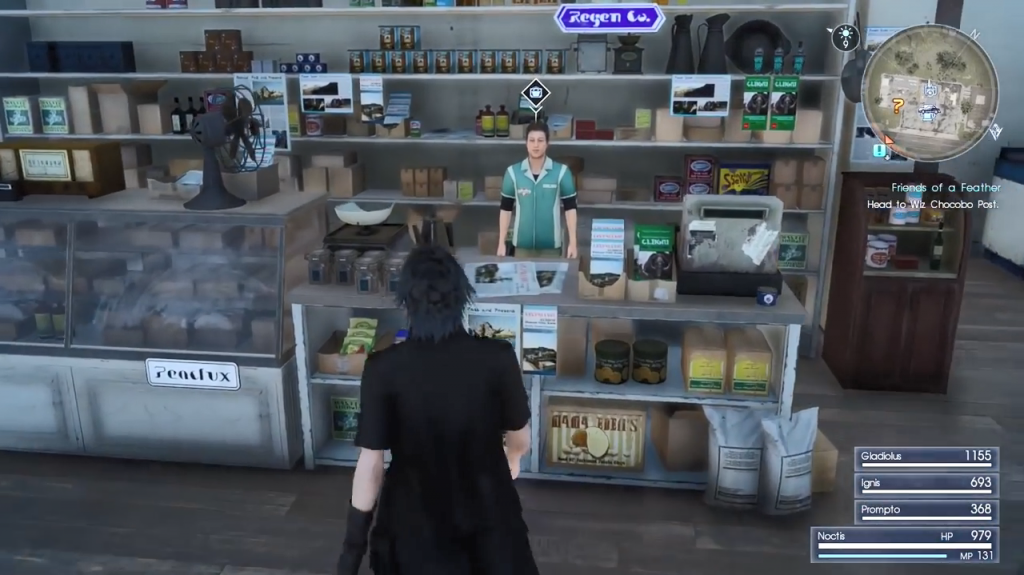
Minwu
(a character from FFII; his name is spelled ミンウ in Japanese)
PuPu
(an alien who can be encountered in FFVIII; “Koyokoyo”/コヨコヨ was the creature’s name in Japanese)
Balamb
(a town in FFVIII)
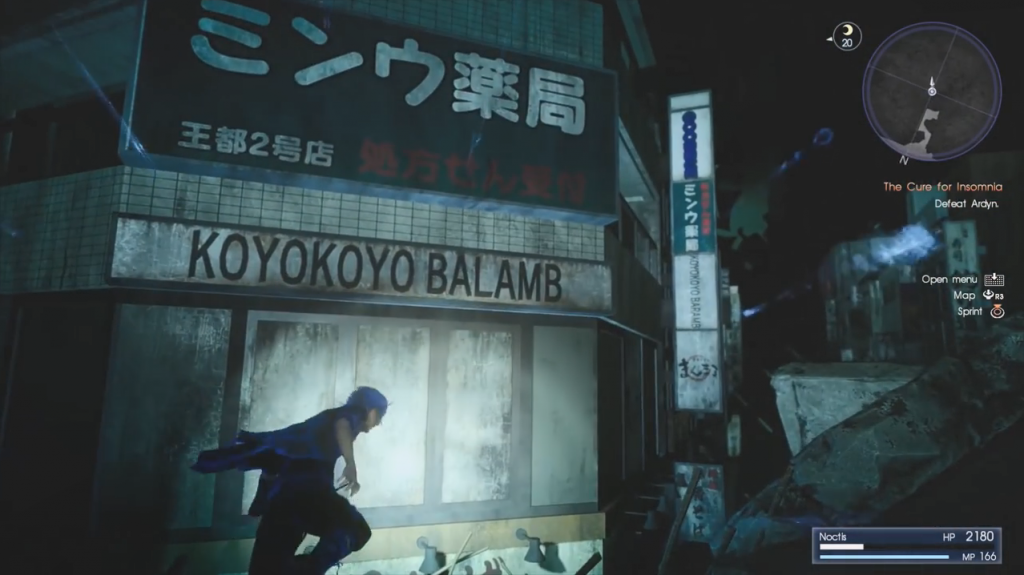
Winhill
(a town in FFVIII)
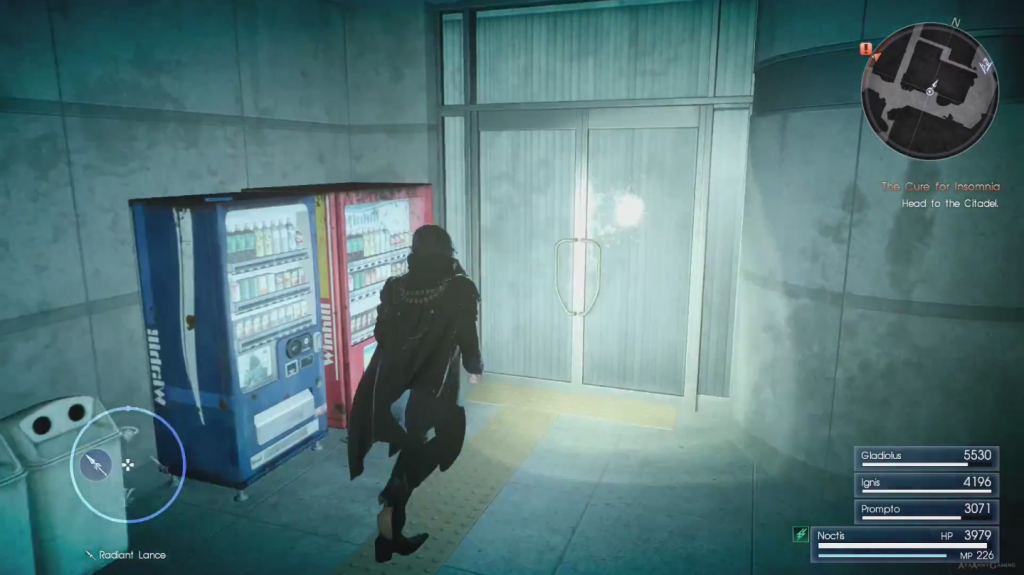
Nanaki
(a main character in FFVII)
YRP
(the abbreviation of the names of the three main characters in FFX-2)
Morrid’s Coffee
(coffee items in FFIX involving a small subquest and an NPC named “Morrid”)
Eiko
(a main character in FFIX)
X-ATM092
(a boss in FFVIII)
Vivi
(a main character in FFIX)
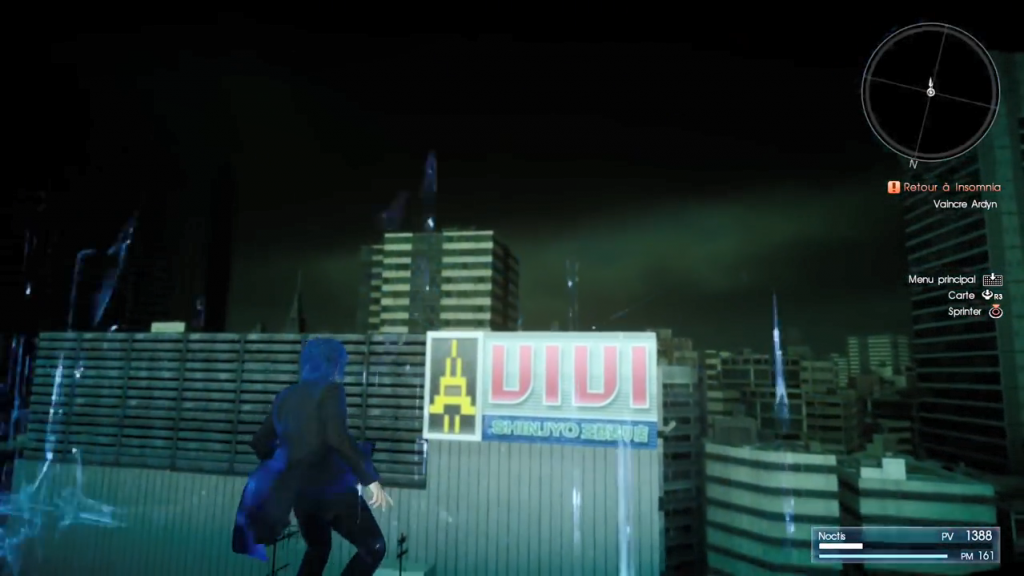
Spira
(the name of FFX’s world)
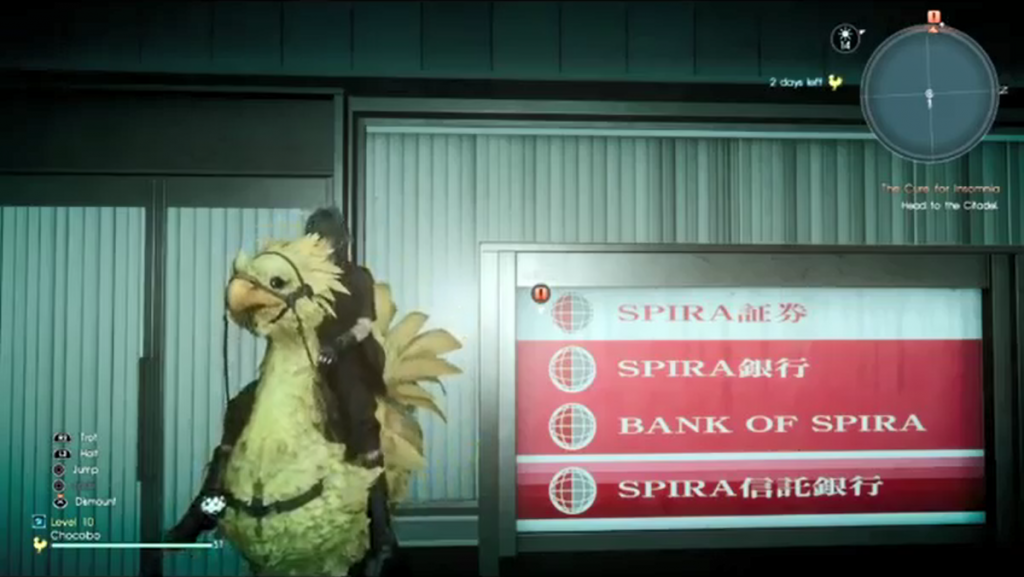
Bevelle
(a city in FFX)
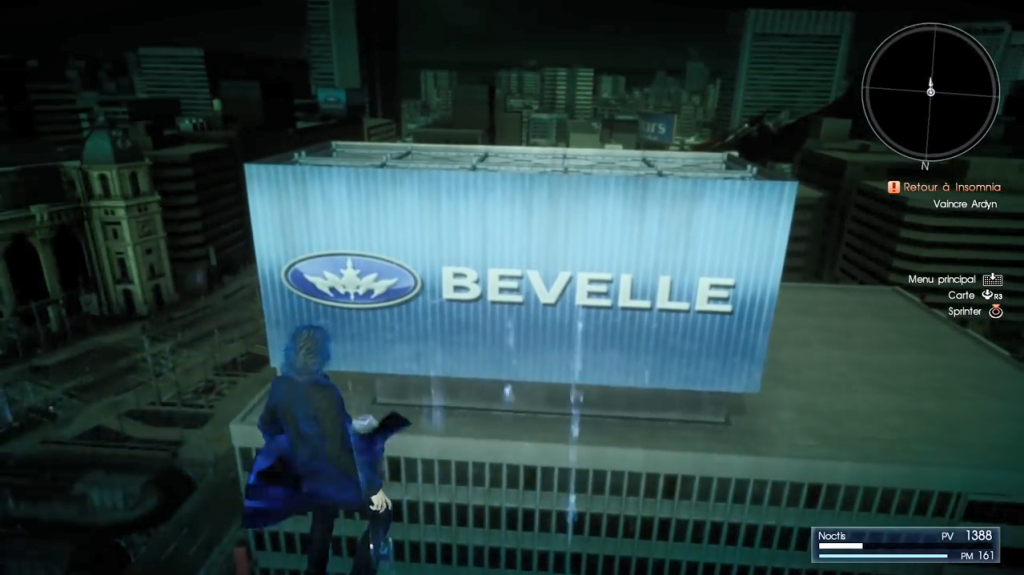
Eclair
(the real name of Lightning, the main character in FFXIII)
Lindzei
(the name of a fal’Cie god from the Fabula Nova Crystallis mythology)
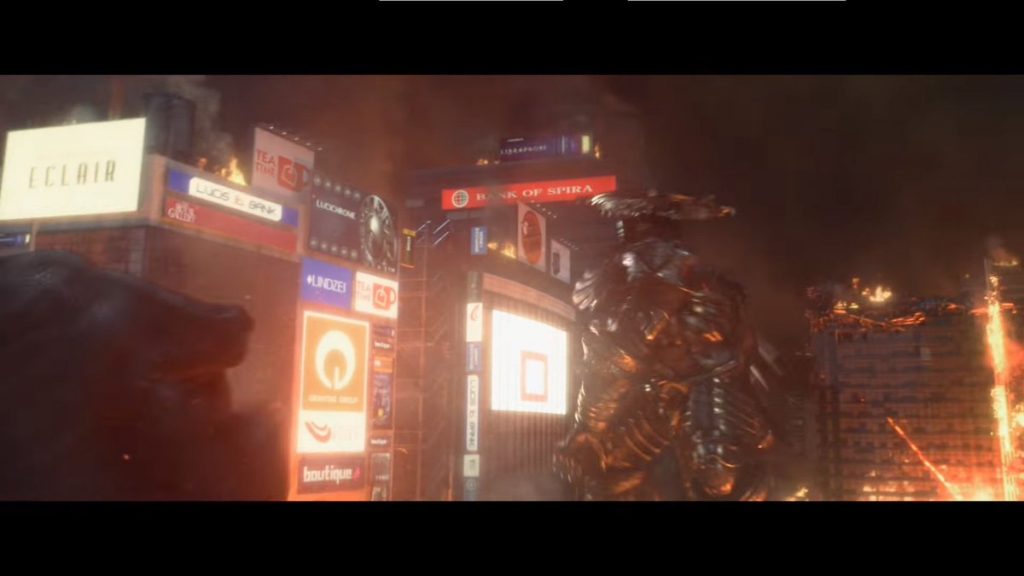
Cosmos
(character in the Dissidia: Final Fantasy titles)
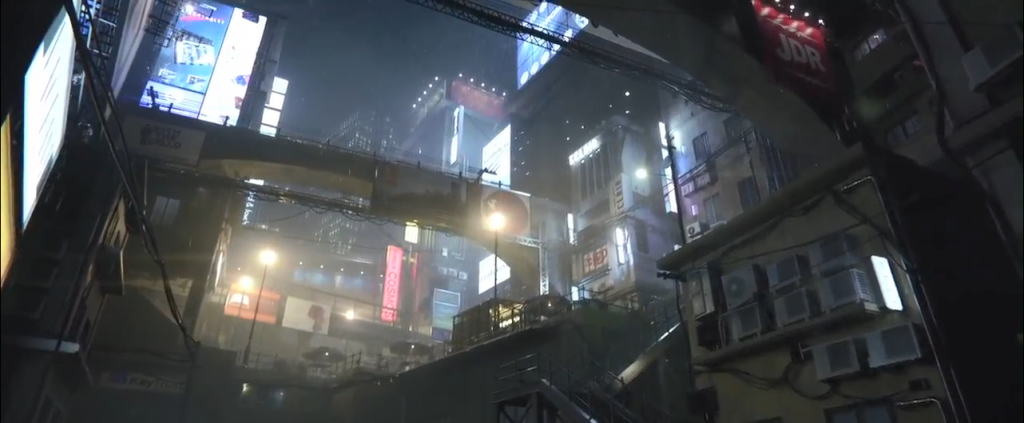
Zeal Palace
(a location from “Chrono Trigger”; though not exactly a Final Fantasy title, it is closely related)
Banora White
(a type of apple featured rather prominently in Crisis Core)
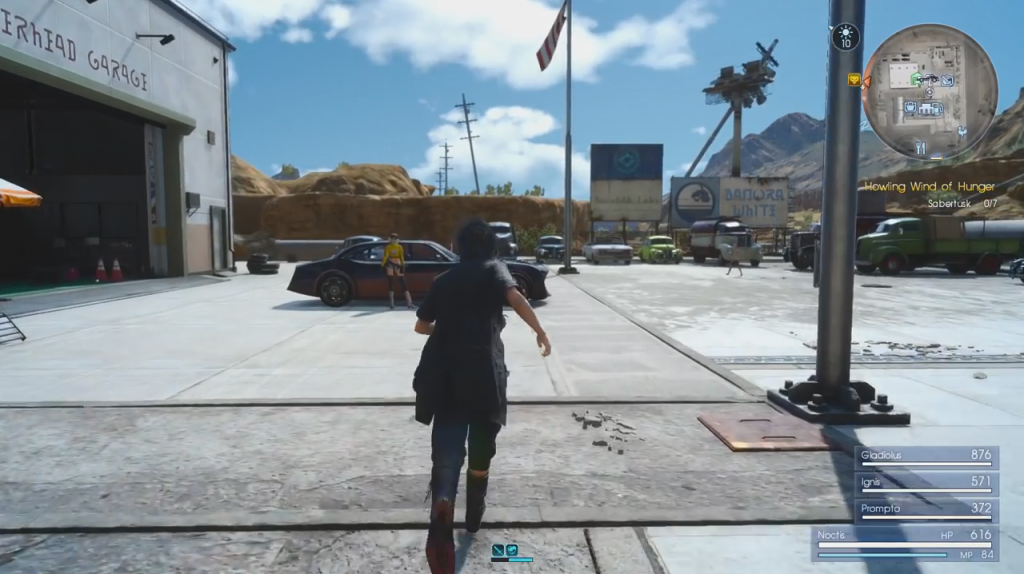
Junon Super Engine Oil
(Junon is a city in FFVII)
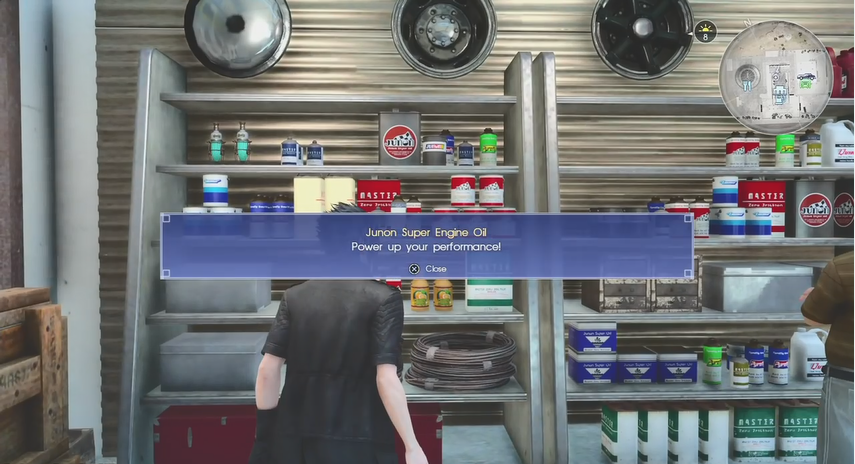
Great Glacier Cola
(the Great Glacier is a location in FFVII)
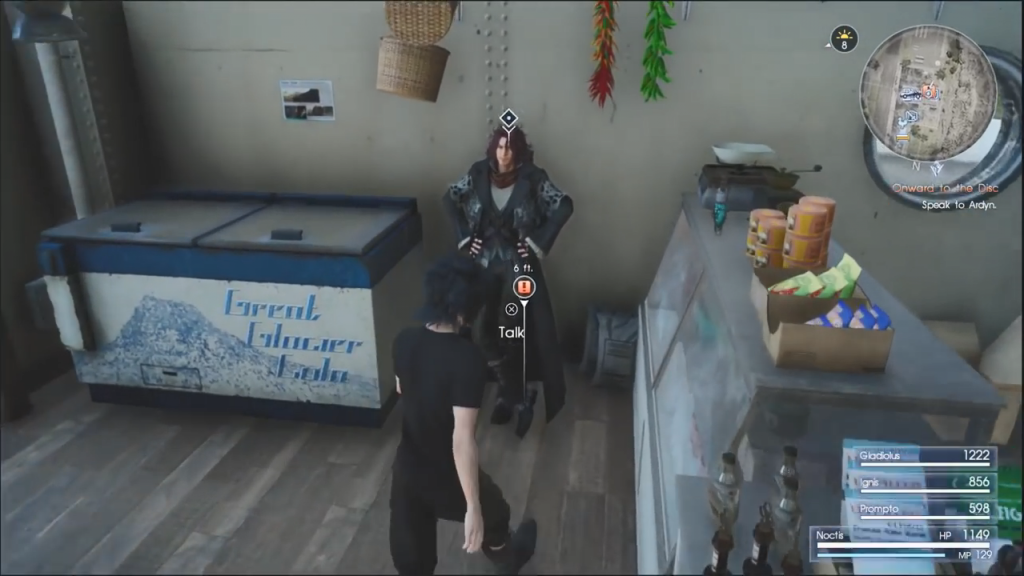
Allusions to/artifacts of the Fabula Nova Crystallis
As you may know, when originally announced, Final Fantasy XV was called “Final Fantasy Versus XIII,” and was intended to be part of the Fabula Nova Crystallis project, a loosely related series of Final Fantasy games connected by elements of a common mythology (included in this were Final Fantasy XIII and Final Fantasy Type-0). Square Enix also explained that the Latin name of the project meant “New Legend of the Crystal.”
Owing to various causes, Versus XIII became Final Fantasy XV (or “FFXVersus” as some fans began referring to it), and was separated from the Fabula Nova Crystallis, along with FF Type-0. Though FFXV would end up further removed from its FNC origins than Type-0, some elements of the FNC and Versus XIII itself nonetheless remain in the final game, as we will see.
Though we know little with certainty about the plot that would have been featured in Versus XIII, obvious vestiges remain in Final Fantasy XV — though what this fan suspects are the new plot elements seem “louder,” for lack of a better word. At times, it feels much like XV’s world setting comes from two quite different mythologies being combined, with the newer one taking center stage.
For example, one can’t help but feel that FFXV’s gods were not part of the original plot that would have featured the fal’Cie gods seen in Final Fantasy XIII and its sequels — even despite the crystalline soul fragments floating about when Noctis summons them seemingly invoking the notion of them emerging from the Unseen Realm a la FFXIII’s Eidolons. In any case, we know these gods of Eos dwelled within the confines of the planet, in contrast to FFXIII’s summons, who emerged from and returned to the Unseen Realm at each summoning.
Let us move forward with this analysis, though, lest we get any further ahead of ourselves.
Etro painting and rooftop party
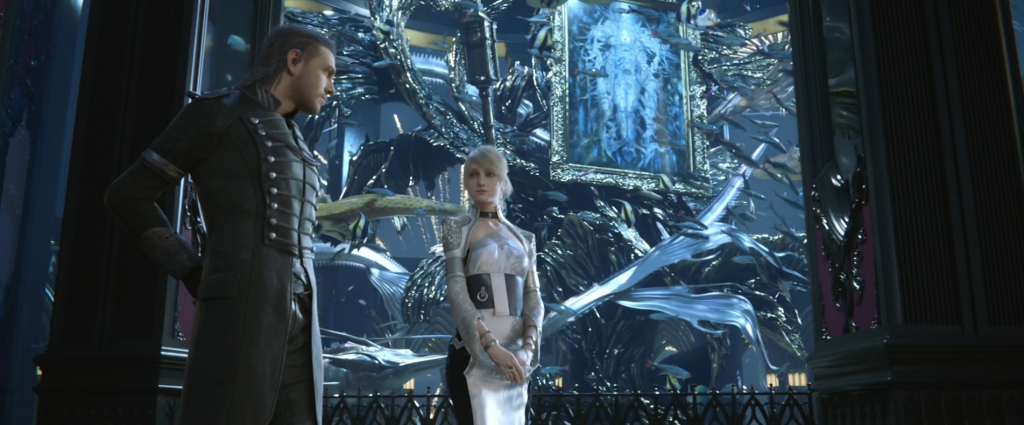
Yoshitaka Amano’s concept art of the goddess Etro — perhaps the central figure of the FNC mythology — appears in the background during a scene from “Kingsglaive: Final Fantasy XV.” (Incidentally, a marine animal that resembles Leviathan also appears here in the aquarium.)
The scene in question takes place during a party held the night before what was ostensibly to be the peace treaty signing between Niflheim and Lucis, but was actually adapted from a scene originally to be featured in Final Fantasy Versus XIII. Here, Noctis would have met Stella Nox Fleuret of Tenebrae (a character eventually adapted into Lunafreya) during a party, and they would have discussed Etro and other metaphysical matters while the camera focused on the painting.
The adapted scene in “Kingsglaive” has Nyx Ulric meeting Lunafreya during this party instead, and the subject matter is significantly different. Nonetheless, many elements remain the same: the “Somnus” theme still plays, there’s still an aquarium in the background, and the location of the party is still the upper levels of a three-tiered building in Insomnia.
The initial trailer from 2009 presenting the original vision for the scene can be viewed here while a 2011 trailer available here contains some updated elements from the original.
The latter trailer establishes the building in which the party takes place to be a fairly close match conceptually for the building found in “Kingsglaive,” even if its rooftop mingling area has been modified for the movie to be more open air than glass enclosed:
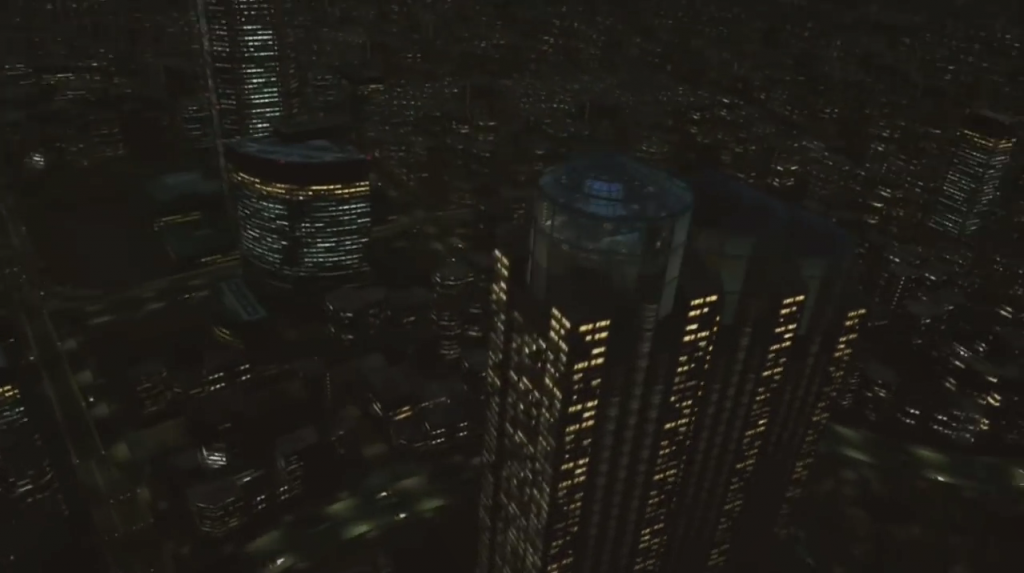
Finally, this exploration and analysis video by fan Caelum Rabanastre XII/XV adequately demonstrates that this artifact of Final Fantasy Versus XIII’s Insomnia remains even in the final game.
Standoff between Emperor Aldercapt and King Regis
The scene from “Kingsglaive” in which the emperor reveals his treachery during the treaty signing is an overt reference to/adaptation of the similar scene teased for Versus XIII as far back as the 2011 trailer — and is especially similar to the version seen in the 2013 trailer revealing Versus XIII’s rebranding as Final Fantasy XV.
“Guess I’ve grown some these ten years”
The game’s final chapter taking place ten years after the rest of the game is a thinly veiled case of the developers waxing meta in reference to Final Fantasy XV being released ten years after it was originally announced as Final Fantasy Versus XIII.
Prompto’s commentary on the King of Light prophecy
At the end of the game, when examining one of the paintings in the hall outside the Citadel throne room, the following exchange will take place (see this video for the conversation as it is displayed in the English version of the game):
Ignis: Ironically, since he was to be the King of Light.
Noctis: And only I can deliver him from his own darkness.
Prompto: My buddy’s gonna write the last chapter of the legend. So cool.
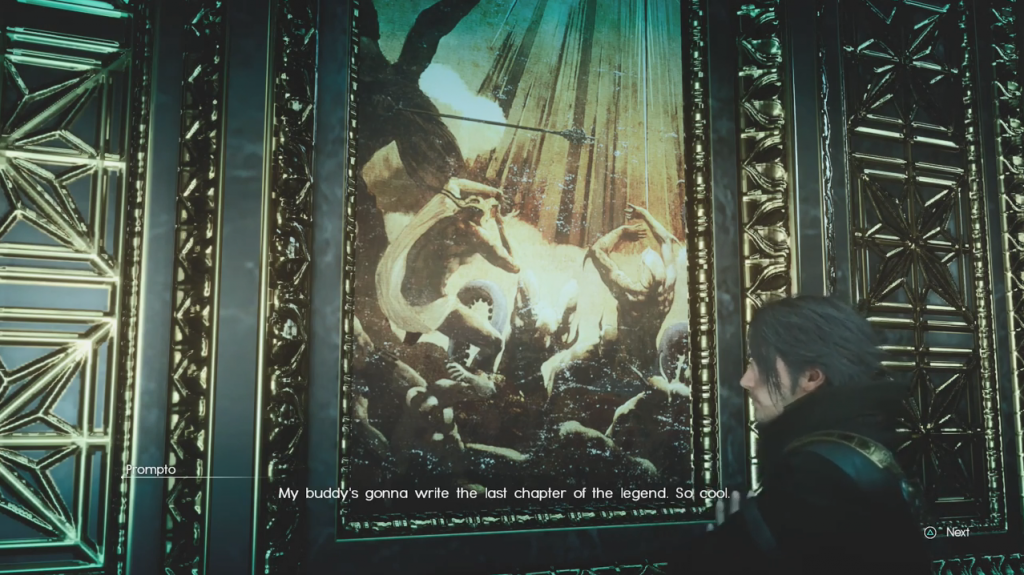
For his last line above, Prompto says “そうやって神話の最後をノクトが作るんだね in Japanese (for reference, see 34:58 in this video), meaning “And like that, Noct is going to bring the finale to the legend.”
This may be meta commentary on Final Fantasy XV itself bringing a certain real-life legend to a close.
You’ll recall that FFXV was originally supposed to be part of the Fabula Nova Crystallis family of Final Fantasy titles. You may also recall that Square Enix said “Fabula Nova Crystallis” means “New Legend of the Crystal.” Though, granted, SE used a different Japanese word for “legend” in that statement (“新しいクリスタルの物語,” with “物語” meaning “legend”), that word is considered a synonym of “神話,” the word Prompto used.
This in mind, one then feels compelled to wonder if the intended implication here is about Final Fantasy XV closing the door on the FNC once the final boss is defeated in light of FFXV being the last title originally announced in the project to see release.
Daemons
What the English script calls “daemons” is シガイ in the Japanese game. This is the same word that was used in Final Fantasy XIII’s Japanese script for what the English localization called “Cie’th,” though it was rendered there like so: シ骸.
On a related note, Ravus’s daemon form bears a striking resemblance to Snow Villiers’s Cie’th form in Lightning Returns.
Floating crystal fragments
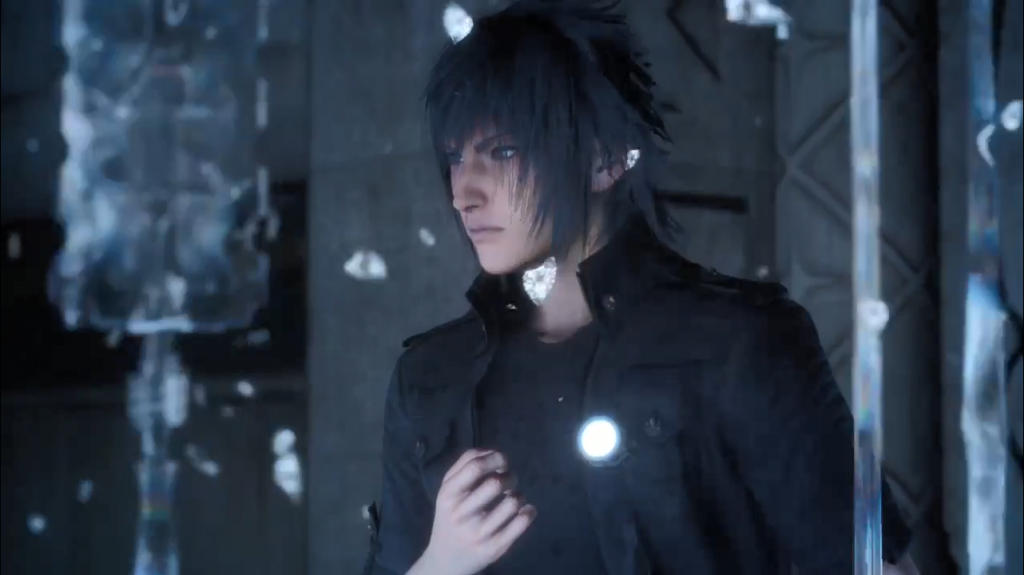
This visual associated with Etro’s Gate opening in the FFXIII trilogy appears in a number of places throughout Final Fantasy XV’s development, including the finished game. These appearances include:
• Older trailers, including those for Versus XIII
• In the “Episode Duscae” demo, when Noctis’s HP is at zero
• In the finished game, when Noctis acquires new royal arms; when he or his friends conjure weapons; and when the prompt to summon one of the gods appears
• In the game’s final post-credits scene with Noctis and Lunafreya

